 Wearable Computing
Wearable Computing
 Wearable Computing
Wearable Computing
Wearable Computing is the logical consequence of the ongoing miniaturization of computer hardware and peripherals. Such systems are intended to be used in a seamless way like a piece of clothing. Interaction with such systems cannot be done in the "usual way" with keyboard, mouse, and monitor, but must use more direct methodologies of interaction, as not to disrupt the ongoing activities of the user. Wearable computing technology is not yet there at a state where seamlessly and ubiquitously being could be used. But progress continues to shrink hardware and at the same time makes it more powerful to deal with the significant computing load of seamless interaction.
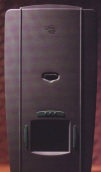
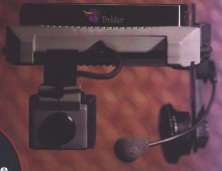 In the late 1990s, Rockwell produced the TREKKER, a rugged wearable computer, based on a 120 MHz
Pentium,
with built-in DSP support for speech interface and a monocular head-worn display.
It was a first start of commercially available
wearable computing hardware, and it had its niche application in the manufacturing shop
floor. I was lucky to get one of these expensive units ($10,000) as part of my work at the
Rockwell Science Center and to explore its capabilities in our research activities.
In the late 1990s, Rockwell produced the TREKKER, a rugged wearable computer, based on a 120 MHz
Pentium,
with built-in DSP support for speech interface and a monocular head-worn display.
It was a first start of commercially available
wearable computing hardware, and it had its niche application in the manufacturing shop
floor. I was lucky to get one of these expensive units ($10,000) as part of my work at the
Rockwell Science Center and to explore its capabilities in our research activities.
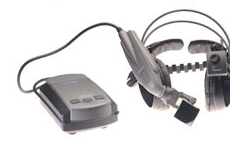 As
the CPUs and motherboards became smaller and more integrated, more powerful
solutions became available. The Xybernaut
Mobile Assistant followed the design of the Rockwell
Trekker - although significantly smaller - and provided more computing power.
As
the CPUs and motherboards became smaller and more integrated, more powerful
solutions became available. The Xybernaut
Mobile Assistant followed the design of the Rockwell
Trekker - although significantly smaller - and provided more computing power. 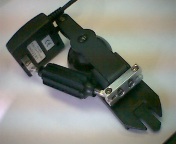 This wearable computer came with a camera that could
be mounted near the head-worn monocular display.
We modified the mounting to provide a more sturdy fixation, with the possibility to
change the pitch angle. The computing power of this PC encouraged us to build the
wearbale testbed WIMMIS (see below).
This wearable computer came with a camera that could
be mounted near the head-worn monocular display.
We modified the mounting to provide a more sturdy fixation, with the possibility to
change the pitch angle. The computing power of this PC encouraged us to build the
wearbale testbed WIMMIS (see below).
 A different form factor was used by Via: the computer was in the shape
of a belt and could truly be worn. Both the Xybernaut and the Via proved to be very useful
devices in our prototype developments and experiments involving wearable computing systems
and the interface technologies associated with wearable computing.
A different form factor was used by Via: the computer was in the shape
of a belt and could truly be worn. Both the Xybernaut and the Via proved to be very useful
devices in our prototype developments and experiments involving wearable computing systems
and the interface technologies associated with wearable computing.
The Saintsong
Espresso PC represented a different design approach: not really designed as a wearable
 rugged computer, it was more like a "cool" miniature PC for conventional desktop tasks.
We used it in a demonstration of computer vision
and Augmented Reality.
rugged computer, it was more like a "cool" miniature PC for conventional desktop tasks.
We used it in a demonstration of computer vision
and Augmented Reality.
The latest development in wearable computing is the
Charmed PC, based on a Boser motherboard
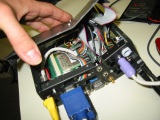 with
a 800 MHz Transmeta CPU. We built a system for 3D audio auralization around this platform, installing a 802.11b
miniPCI bus card with 2 antennas and a Trimble GPS within the enclosure.
with
a 800 MHz Transmeta CPU. We built a system for 3D audio auralization around this platform, installing a 802.11b
miniPCI bus card with 2 antennas and a Trimble GPS within the enclosure.
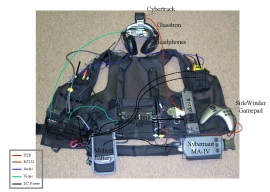 In
1999, we decided to demonstrate a system that would provide a user with a immersive
Augmented Reality display for immersive terrain visualization.
This "Wireless Immersive MultiMedia Information System (WIMMIS)" featured
a Cybertrack head tracker for orientarion determination, a Sony Glasstron
TM head-worn see-through display, a Xybernaut
MA 4 wearable computer, and a wireless video link by Coherent. The head orientation was captured by
the wearable PC and sent through wireless communication to a remote server. This server
had a powerful 3D graphics system that could render very large and complex data sets such as
terrain views. The viewpoint of this rendition (ARscape by Clement Tam, RSC) was set by
the user's head orientation, and the resulting
terrain rendition was sent back to the user through the wireless link.
This provided the user with the capability to experience a immersion in a pseudo-outdoor scenario.
If used outdoor in connection with a GPS, the user could then see all the rendered information overlaid onto
the real view of the environment (as seen through the see-through display).
In
1999, we decided to demonstrate a system that would provide a user with a immersive
Augmented Reality display for immersive terrain visualization.
This "Wireless Immersive MultiMedia Information System (WIMMIS)" featured
a Cybertrack head tracker for orientarion determination, a Sony Glasstron
TM head-worn see-through display, a Xybernaut
MA 4 wearable computer, and a wireless video link by Coherent. The head orientation was captured by
the wearable PC and sent through wireless communication to a remote server. This server
had a powerful 3D graphics system that could render very large and complex data sets such as
terrain views. The viewpoint of this rendition (ARscape by Clement Tam, RSC) was set by
the user's head orientation, and the resulting
terrain rendition was sent back to the user through the wireless link.
This provided the user with the capability to experience a immersion in a pseudo-outdoor scenario.
If used outdoor in connection with a GPS, the user could then see all the rendered information overlaid onto
the real view of the environment (as seen through the see-through display).
Based on the Charmed PC by Charmed Technology, we built a system for 3D Audio Augmented Reality. This wearable system featured a GPS and 802.11b connectivity. Connected to a base station, aural cues could be sent to the user, auralizing a certain location in the environment. These aural cues were played through headphones to the user who then could perceive the location of this acoustic source. This technique effectively utilized a perception channel that was not used by the human in this situation.